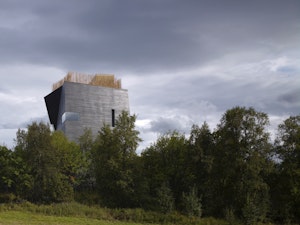This article is taken from the March 2025 issue of The Critic. To get the full magazine why not subscribe? Right now we’re offering five issues for just £10.
On 16 December, 1947, Knut Hamsun, Norway’s most famous living novelist, stood in court to answer charges of treason.
Once revered but now reviled, for years Hamsun had been an ardent proselytiser for Adolf Hitler. He supported the Nazi-backed government of Vidkun Quisling throughout the war following Germany’s conquest of Norway in 1940 and earned the opprobrium of the country when he wrote an obituary following Hitler’s suicide praising him as a “warrior for humankind and a preacher of the gospel of justice for all nations … We, his closest followers, all bow our heads at his death.”
Condemnation was instant and vociferous. His novels, which had earned him the admiration of his country such as Hunger and Pan and the universally well-regarded The Growth of the Soil, which won him the Nobel Prize in 1920, were thrown away or burned. He was arrested and placed under house arrest to await trial and the death sentence.
His career was over, his reputation ruined beyond repair. But was it? An exhibition at the Hamsun Centre, a museum in the northern village of Hamarøy where the writer spent his childhood, promises a “new understanding” of a man they rather carefully describe as a “controversial figure”.
✺
The very fact that the exhibition was part of the celebrations organised by the municipality of Bodø, the country’s European Capital of Culture, suggests that debate over Hamsun persists and will continue to do so.
This ambivalence is evident in the way he was brought to justice. Even then in 1945, the authorities were eager to play down the culpability of such an internationally renowned writer. He was sent to a psychiatric hospital which concluded that his mental faculties were impaired; he was deaf, he was senile, he did not know what Nazism was. The charges of treason were dropped, he was cleared of any direct Nazi affiliation and instead of execution he was forced to pay a hefty fine.

We know, in fact, from his own account of his two years under surveillance, that his faculties were by no means impaired. In his autobiographical On Overgrown Paths, he rails at the “fanatical” judge who is handling his case, he is bitter that he is kept apart from his second wife Marie who was also arrested, mocks the doctors who are evaluating him but also writes poetically about the countryside around him. “I read, ramble and play solitaire,” he writes, insisting the while: “My conscience is clear.”
When it comes to his court appearance his own words reveal a man who was defiantly unrepentant. He knew nothing about the murders, the terror, the torture, he insisted. Just heard a few rumours before he was arrested. “I never took part in meetings,” he writes. “I wasn’t involved in black marketing. I never gave anything to storm troopers or to the National Union party,” (National Union or Nasjonal Samling was a far-right neo-Nazi party) and he disingenuously added: “However it might well be that I wrote in this spirit of the National Union now and then … I don’t know because I don’t know what the spirit of the National Union is.”
The verdict infuriated him. He wanted to be tried for treason, preferring to be judged as a hero standing by his beliefs — wrong or right — rather than a “pitiful madman”. Many wondered whether the “old sinner” could not have been treated more leniently. Some manifestly did reckon he had paid the price, albeit posthumously. Within two years of his death in 1952 aged 92, 15 volumes of his works were published followed in 2009 by an additional 27 volumes of his short stories, poetry, plays and articles as well as a highly sympathetic film of his life starring the Swedish actor, Max von Sydow.
✺
Has he deserved even this degree of rehabilitation? When can the transgressions of an individual be put to one side and the sinner brought back into society’s fold and their work accepted without moral qualm?
It is as if there is a sliding scale of morality, or is it rather, one of expediency? The more admired, the greater the imperative to forgive, or at least ignore, their crimes and move on. One might assume that no one found guilty of rape or paedophilia could be tolerated. But then, to take random examples, a statue by the sculptor Eric Gill still stands outside the BBC’s Broadcasting House despite his incestuous assaults on his children.
The film director, Roman Polanski, is still considered a fugitive by the US criminal justice system after pleading guilty in 1977 to unlawful sex with a 13-year-old but now lives in Europe where, as French film critic Agnès Poirier wrote:
“We are prepared to forgive artists a lot more than we are prepared to forgive ordinary mortals.”
Should we still be able to buy Hitler’s ramblings in Mein Kampf from Amazon for £18.69? Should the antisemite composer Richard Wagner be performed at the Royal Ballet and Opera House?
[He was] a racist, a traitor, but a writer of sufficient renown to warrant his own museum
The uncomfortable truth is that if all writers, artists and musicians were to be judged on their moral rectitude we would be in danger of having empty bookshelves, bare walls and redundant music collections.
Where does the traitor Hamsun stand on the sliding scale? He never achieved the recognition of his countryman, Henrik Ibsen, though Hermann Hesse and Thomas Mann compared him to Fyodor Dostoyevsky and Friedrich Nietzsche while the novelist Isaac Bashevis Singer called him the “father of the modern school of literature in his every aspect — his subjectiveness, his fragmentariness, his use of flashbacks, his lyricism”.
Many of his books capture the spirit of the countryside which the late Professor Atle Kittang from the University of Bergen described as a world of “funerals and festive balls, prayer meetings, suicides and the herring trade in all its diversity”.
His first major success, Hunger, published in 1890, is a feverish account of a young writer trying to survive on the mean streets of Oslo, slipping in and out of a kind of madness. It offers little political or social context but it shocked readers with his hero’s provocative attacks on God and Christianity.
By contrast, in Growth of the Soil the main character, Izak, encapsulates the nobility of the working man, exuding the sweat and toil reminiscent of the Nazi slogan Blut und Boden (“Blood and Soil”) and so impressed the Nazis that the book was distributed to the soldiers fighting in Norway. Joseph Goebbels admired the book so much he invited Hamsun and his wife Marie to Berlin in May 1943 and in return for such agreeable hospitality Hamsun gave Goebbels his Nobel medal.
He capped this by visiting Hitler himself in his residence in Obersalzberg in June 1943. The very deaf, very shouty, Hamsun lectured Hitler on the way he should be running the occupation. Hitler was furious and stormed out of the meeting.
This did nothing to diminish his passion for the purity of the Teutonic world and he maintained a steady stream of pro-German polemic which contrasted with his hostile diatribes about “imperialistic” Britain and his contempt for the “modern” world he discovered in the United States.
In The Cultural Life of Modern America (1889), he described the Native Americans as “simply half-apes” and “the Negroes … a people without a history … a nascent human form from the tropics, rudimentary organs on the body of white society”.
So, a racist, a traitor, but a writer of sufficient renown to warrant his own museum, which by its very existence suggests his reputation is, at least, open to re-evaluation.
✺
Set high in Norway’s Arctic Circle, it is a dramatic, black box of a building, standing starkly against the clear blue of the sea, the forests and the spiky mountains beyond. The new exhibition, appropriately called Messy Corners, uses videos of debates, charts and timelines, lectures and essays, to discuss his life and misdemeanours — he wrote 23 novels, poetry, short stories and an unceasing flow of newspaper articles which discussed infanticide, Norway’s language policy, the damaging effects of tourism on the nation’s health and the perils of lipstick.

As the curator, Alvhild Dvergsdal, says: “We hope to enlighten people with facts, even unpleasant ones, by using critical perspectives, by inviting people into interesting literary landscapes, to show … the best and worst of the man, and allow people to make up their own minds about him.”
To help shape that decision, some contributors have been outright in their condemnation of Hamsun, particularly those from the Sami population, who consider Growth of the Soil to be an attack on their nomadic lives, in the way he belittles them as thieves and cheats. They object to the museum being on their territory at all.
✺
But the debate always comes back to his Nazi sympathies. “We are not finished discussing that,” says Dvergsdal. “People are still angry and disappointed because he had been so popular before.” In an essay for the Centre Professor Kittang attempts to confront the “dark stain” left on his reputation by the Hitler obituary. Was he “the teasing, provoking and publicity-seeking lecturer of his youth?” he asks. “Or the moralising and reactionary preacher who later came to the fore? The anarchist or the Nazi? The questions are rhetorical. Knut Hamsun is … a collection of many contradictory personalities.”
Where does that leave him on the sliding scale of moral acceptability? Inevitably, perhaps, the ambiguity remains. “We can’t help loving him, though we have hated him all these years,” wrote a Norwegian biographer in 2009, the year the museum opened. “That’s our Hamsun trauma. He’s a ghost that won’t stay in the grave.”







